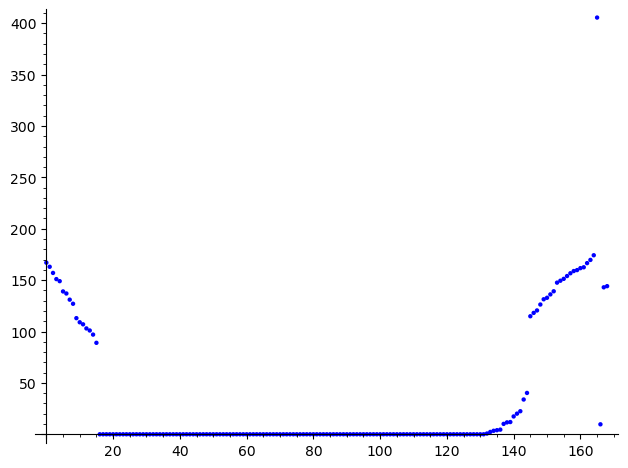Consider the completely additive function $\eta(n) := \sum_{p|n} v_p(n)p$ defined on natural numbers, with values in natural numbers. For literature, on this function, see the corresponding OEIS sequence. Consider the Gram matrix:
$$G(n) := (k(a,b))_{1 \le a,b \le n}$$
where
$$k(a,b) = \eta(\gcd(a,b))$$
is a positive semi definite kernel on the natural numbers, because with $\phi(n) := \sum_{p|n} \sqrt{v_p(n)p} e_p$ we can embedd $n$ in the Hilbert space of series over $\mathbb{R}$ or $\mathbb{C}$ and we have $k(a,b) = \langle \phi(a),\phi(b) \rangle$
The game for the natural numbers is like this:
Given two natural numbers $a,b$, what is the minimal cost of a series transformation from $a$ to $b$. A transformation is multiplication / division with a prime number $p$ and its cost is $p$. For a series of transformations, the cost is the sum of transformations in the series. (Spoiler: The answer is independent from the chosen series and is
$\eta(\frac{ab}{\gcd(a,b)^2})$
which can be seen by introducing a graph $G = (\mathbb{N},E)$ on the natural numbers, where the edges $a \approx b$ are defined through
$$(a,b) \in E \iff \frac{a}{b} \text{ or } \frac{b}{a} \text{ is prime}$$
with weights on the edges equal to $w((a,b)) := \max\{a/b,b/a\} = $ a prime number.
A path from $a$ to $b$ corresponds to a series of transformations in the game above, and a shortest path, corresponds to a series of transformations of minimal cost.
The connection to the graph and the Gram matrix is given by the shortest path distance:
$$d_s(a,b) = \eta( \frac{ab}{\gcd(a,b)^2} ) = \eta(a)+\eta(b)-2\eta(\gcd(a,b)) = |\phi(a) - \phi(b)|_{H}^2 = d_H(a,b)^2$$
where the subscript $H$ denotes the Hilbert space of series.
It is fun and somewhat surprising to look at the spectrum $\sigma(G(n))$ of these Gram matrices:
 $G(169)$" />. One can recognize three parts:
$G(169)$" />. One can recognize three parts:
$$\sigma(G(n)) = \sigma_p \cup \sigma_c \cup \sigma_0$$
where $\sigma_p := \{ \lambda \in \sigma(G(n)) | \lambda \in \mathbb{N} , n/2 < \lambda \le n \}$ and
$\sigma_c := \{ \lambda \in \sigma(G(n)) | \lambda \notin \mathbb{N} , n/2 < \lambda \le n \}$ and $\sigma_0 := \{ \lambda \in \sigma(G(n)) | 0 \le \lambda \le n/2 \}$
Furthermore, looking at the numbers of $\sigma_p$ we recognize that these are exactly the prime numbers $p$ with $n/2 < p \le n$. That these prime numbers are a subset of $\sigma_p$ can be proven by observing that the $p$-th row and column in the Gram matrix consists of $0$s everywhere except at the diagonal where it has entry $p$. So by permuting this $p$-th column and then $p$-th row. We see that the matrix becomes a block-diagonal and can see that $n/2 < p \le n$ are eigenvalues. The off diagonal zeros can be explained because $k(a,p) = \eta(\gcd(a,p)) = \eta(1) = 0$. Using the embedding $\phi(n)$ we can define a linear operator $R(e_n) := \phi(e_n)$ on the standard basis $(e_n)_{n \in \mathbb{N}}$ of $H$ and with this, we can define an unbounded, self-adjoint, linear and positive semidefinite operator on $H$:
$$O = R^* R $$
Searching for theorems and usages of unbounded, self-adjoint operators , I found Theorem 5.7 on Schmüdgen's "Unbounded self-adjoint operators on Hilber spaces":
Let $A$ be a self-adjoint operator on a Hilbert space $H$. Then there exists a unique spectral measure $E = E_A$ on the Borel Sigma-algebra $B(\mathbb{R})$, such that:
$$A = \int_{\mathbb{R}} \lambda d E_A(\lambda)$$
The idea is to transform $t$ to $t(1+t\cdot t)^{-1/2}$ to get from unboundend to bounded and backwards. However I am not sure, if this theorem can be applied for $A=O$ as above, and if it can applied, if it is possible to compute the integral above directly? (Q1)
In the German Wikipedia article of "spectra measure" there is an interesting observation from Quantum Mechanics of observables, which can be roughly divided in three parts:
the point spectrum ( one uses sums) [This would correspond I think to the prime numbers defined above]
the continuous spectrum (one uses integrals) [This would correspond to the $\sigma_c$ I think, $c$ for continuous.
very seldom there is a singular-continuous spetral part, which I think would correspond to $\sigma_0$.
I am curious, if any of these observations can be proven? (Q2)
The properties defining the kernel $k(a,b)=\eta(\gcd(a,b))$ are: Suppose $k$ is a p.s.d kernel function (symmetric) on the natural numbers, such that:
$\gcd(a,b) = 1 \iff k(a,b) = 0$
$k(p^a,p^a) = ap$ for all primes $p$ and $a\ge 0$
$k(\frac{ac}{\gcd(a,c)^2},b) = k(\frac{a}{\gcd(a,c)},b) + k(\frac{c}{\gcd(a,c)},b)$
It is a little bit fun and crazy to think about what conjectures this function $\eta$ might also satisfy:
$$\forall a,b : \frac{a+b}{\gcd(a,b)} < \eta(\frac{ab(a+b)}{\gcd(a,b)^3})^2$$
which is obviously inspired by the abc-conjecture, and as a consequence, would maybe have an application for FLT:
$$z^n < \eta((xyz)^n)^2 = n^2 \eta(xyz)^2 = n^2( \eta(x) + \eta(y) + \eta(z))^2 $$ $$\le^{\text{ because } \eta(a)\le a} n^2 ( x+y+z)^2 \le n^2(3z)^2 = 9 n^2 z^2$$
and since $n>2$ we would get:
$$z^{n-2} \le 9n^2$$
and again since $n-2>0$ we woud derive:
$$z < \exp(\frac{\log(5n^2)}{n-2})$$
But the right hand side of this inequality is $<2$ for $n\ge 13$. So this would mean that
$$x^n+y^n = z^n, 1 \le x \le y \le z, \gcd(x,y)=1, n>2$$
would have no solution for $n\ge 13$. This is of course wild speculation, because the abc-inequality for $\eta$ has yet to be tested if it is true or not, but let me get a little bit crazier and get back to my favourite topic, p.s.d kernels defined over the natural numbers, and point to the symmetric function, which also seems to be a p.s.d kernel:
$$K(a,b):=\frac{a+b}{\gcd(a,b) \eta( \frac{ab(a+b)}{\gcd(a,b)})^2}$$
The abc-conjecture for $\eta$ might than be restated as:
$$\forall a,b \in \mathbb{N}: K(a,b) < 1$$
Q3) It would be nice to check this inequality for many numbers and report with or without code a counterexample or that it has succeded for these examples?
